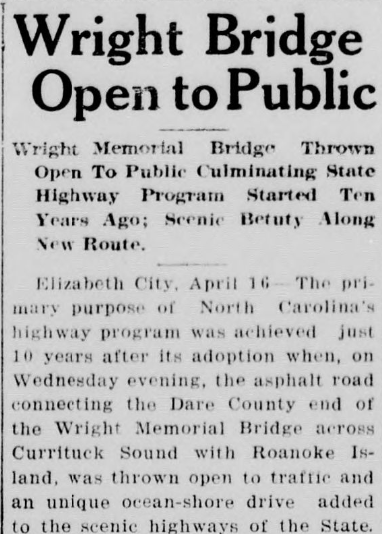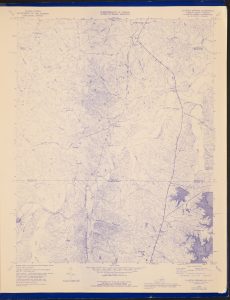
Map of Cluster Springs, Virginia in Halifax County (1968)
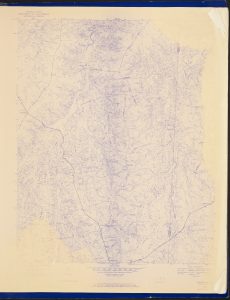
Map of Ridgeville, North Carolina in Person County (1968)
Thanks to our partner, Person County Public Library, Digital NC has now digitized maps from several counties and communities in North Carolina and Virginia. Several maps in the collection include the Ridgeville Quadrangle taken in 1968 of the small community of Ridgeville in Person County, the Cluster Springs Quadrangle from 1968 representing the community of Cluster Springs, Virginia, located in Halifax County, and the Hurdle Mills Quadrangle map from 1980 representing the small community of Hurdle Mills in Person County. Along with these maps, the collection includes maps from the 1970s and 1980s of communities in Person County.
Special thanks again to our partner Person County Public Library for the chance to digitize these maps. If you want to see more items from Person County Public Library, visit their collection.
Visit here to see more items in our Images of North Carolina collection.
![Header for The Roanoke News. It reads: The Roanoke News. Established in 1866--Serving Halifax and North [H]ampton counties.](https://www.digitalnc.org/wp-content/uploads/2022/02/download.png)
Thanks to funding from the State Library of North Carolina’s LSTA Grant and our partner, Halifax County Library System, new issues of The Roanoke News from 1923 to 1944 are now available on our website. This expands our current holding of the paper from 1878 to 1944. The paper, published weekly, primarily features articles on local, North Carolina news such as the completion of the Wright Memorial Bridge.
Prior to 1931, individuals looking to visit North Carolina’s Outer Banks, or those wishing to visit Dare’s county seat in Manteo, would have had a rather long trip ahead of them. In 1921, the General Assembly passed a $50 million bond issue that was to be used for improving and paving roads that would connect county seats. In addition to these new roads, several concrete bridges were constructed that shortened the distance between places significantly. One of the bridges constructed under the bond was the Wright Memorial Bridge. In April of 1931, the Wright Memorial Bridge was finally opened to the public after 10 years of construction. The bridge spans the entire three mile width across Currituck Sound, connecting Point Harbor to the Outer Banks. The bridge still enjoys heavy usage almost 100 years later.
To learn more about the Halifax County Library System, please visit their website.
To view more newspapers from across North Carolina, please click here.
Back in August, we announced our annual call for microfilmed newspaper digitization. We asked institutions throughout North Carolina to nominate papers they’d like to see added to DigitalNC. As it is every year, it was an incredibly tough choice – we are typically able to choose between 40-60 reels out of over 300+ nominated. This year we’ve chosen the following titles and years.
| Title |
Years |
Nominating Institution |
| The Alleghany Times / News / Star-Times (Sparta, N.C.) |
1933-1947 |
Alleghany County Public Library |
| The Charlotte Labor Journal and Dixie Farm News (Charlotte, N.C.) |
1939-1953 |
UNC Charlotte |
| The Daily Record (Dunn, N.C.) |
1963-1965 |
Campbell University |
| The Eagle (Cherryville, N.C.) |
1942-1954 |
Cherryville Historical Museum |
| The Highlander (Highlands, N.C.) |
1937-1978 |
Highlands Historical Society |
| The Kings Mountain Herald (Kings Mountain, N.C.) |
1958 |
Mauney Memorial Library |
| North Carolina Catholic (Nazareth, N.C.) |
1946-1968 |
Catholic Diocese of Raleigh |
| The Roanoke News (Weldon, N.C.) |
1923-1944 |
Halifax County Library System |
| The Valdese News (Valdese, N.C.) |
1938-1950 |
Burke County Public Library |
| The Yadkin Ripple (Fort Bend, N.C.) |
1893-1944 |
Yadkin County Public Library |
For our selection criteria, we prioritize newspapers that document underrepresented communities, new titles, papers that come from a county that currently has little representation on DigitalNC, and papers nominated by new partners. After selection, we ask the partners to secure permission for digitization and, if that’s successful, they make it into the final list above.
We hope to have these titles coming online in the first half of 2022.
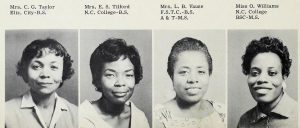
Faculty portraits in the 1963 Longhorn by Woodington High School.
More than 60 high school yearbooks provided by Eastern Carolina University are now up on DigitalNC. The schools represented are located across central and eastern North Carolina and include schools from Pitt County, Franklin County, Stokes County, Washington County, Hertford County, Lenoir County, Martin County, Halifax County, Wilson County, and Johnston County. The dates of these yearbooks range from 1927-1970. Together, they give an overview of secondary education across the state, with many of the editions covering the time surrounding desegregation efforts. These yearbooks include individual and class portraits as well photographs documenting activities, clubs, sports, and academics.

Senior portraits from the Kay Aitch Ess 1927 yearbook by Grainger High School
Follow the links below to browse yearbooks from the schools included in this batch:
To see more materials from our partner who provided these yearbooks, visit East Carolina University’s partner page, or take a look at their website.
This week our colleagues at the North Carolina State Library are focusing on Halifax County as their county of the week. We are taking the opportunity to again dive a bit deeper into some of our city directories from that county. Two cities from Halifax County have directories in DigitalNC: Roanoke Rapids and Scotland Neck.
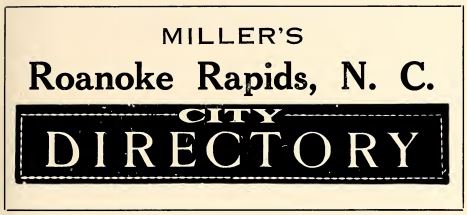
The directories from Roanoke Rapids, which cover 1938 until 1963, were all published by the Southern Directory Company, which was based in Asheville, NC, and are all Miller’s Directories. Roanoke Rapids, which is Halifax County’s county seat, was a rapidly growing town during the period the directories were published. In addition to the expected listings of businesses and addresses of citizens of Roanoke Rapids, the directories all include detailed descriptions of facilities in the town, including public works, churches, schools, and amusements. There are also descriptions of the population of the town and all the counties in NC, and the tax rates in the town and county at the time.

Directory of local facilities in town from the 1938 Roanoke Rapids City Directory
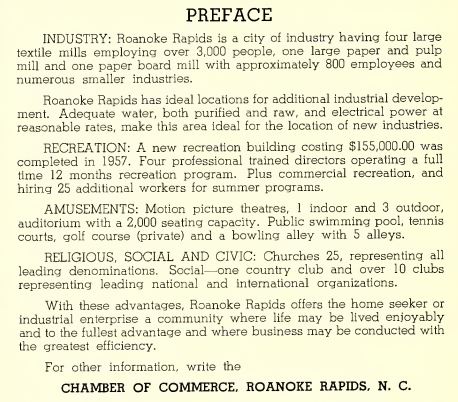
Information about facilities in town from the 1958 city directory
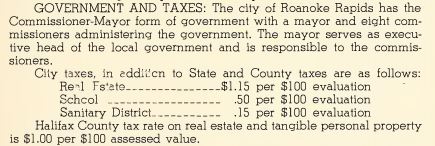
Taxes in Roanoke Rapids from the 1958 city directory
There are two directories from Scotland Neck, which cover 1960-1962. Scotland Neck’s directories were published by Hill Directory Co., Inc., based out of Richmond, VA. These directories do not included detailed descriptions of the town, just the basic ads, telephone directory and address directory for Scotland Neck and the surrounding area. The ads in the Scotland Neck directories all include well done drawings by the publication company, making that section more appealing for consumers compared to the Miller directories for Roanoke Rapids.


To learn more about city directories, check out past blog posts here. And to view more city directories from across North Carolina, visit the City Directories Collection on DigitalNC.
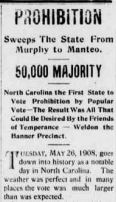
Headline in the Roanoke News, May 28, 1908 From the Halifax County Library
94 years ago today, on January 17, 1920, the United States officially became a dry country, as the 18th Amendment banning the sale, production, importation, and transportation of alcoholic beverages went into effect. However, in North Carolina, it had little effect as the state had enacted prohibition via a referendum vote twelve years earlier on May 26, 1908, becoming the first in the south to ban alcohol.
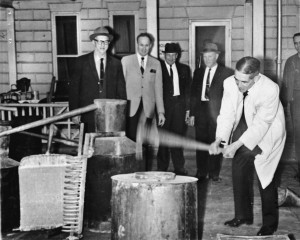
Moonshine still being destroyed in Davie County, 1912 From Davie County Public Library
Prior to the full country being under Prohibition, North Carolinians would drive to Virginia or South Carolina to procure their alcohol and bootlegging quickly became good business in the state and those early bootleggers who fixed up their cars to be as fast as possible laid the ground for race car driving and eventually, NASCAR. Once full prohibition was in effect across the country, moonshiners also did quick business. In DigitalNC there are several photographs and newspaper articles about those who were caught by police attempting to make or transport liquor and many more expressing editorial opinions for and against prohibition.
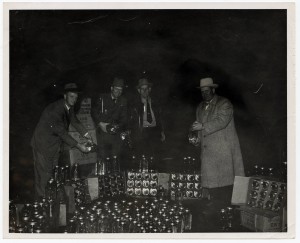
Sheriff captures 126 gallons of bootleg whiskey in Rockingham County, NC From Rockingham Community College
While nationwide prohibition ended with the 21st Amendment’s passage in 1933, North Carolina did not ratify the amendment and it was not until 1937 when the Alcohol Beverage Control (ABC) system was set up in North Carolina counties to sell alcohol that prohibition officially ended in North Carolina. However, many counties still remained dry well after 1937 and post prohibition moon-shining and bootlegging was still a common occurrence in the mid 1900s. Today, Graham County remains as the only fully dry county in the state. To learn more about prohibition in North Carolina, check out this post from the North Carolina Collection and this article in NCpedia.
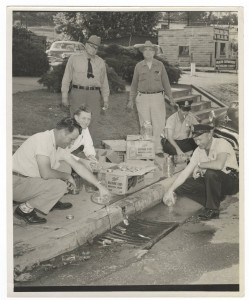
Officers in Spray pour illegal whiskey down the storm drain in the 1950s. From Rockingham Community College
The following newspapers were digitized from microfilm in 2011 and 2012.
| Title |
Years |
Nominating Institution |
| The Mebane Leader |
1911-1915 |
Alamance County Public Library |
| Highland Messenger (Asheville) |
1840-1851 |
Buncombe County Public Library |
| The Standard (Concord) |
1888-1898 |
Cabarrus County Public Library |
| Daily Concord Standard |
1895-1899 |
Cabarrus County Public Library |
| Mecklenburg Jeffersonian (Charlotte) |
1841-1849 |
Charlotte Mecklenburg Library |
| Miners’ and Farmers’ Journal (Charlotte) |
1830-1834 |
Charlotte Mecklenburg Library |
| Catawba Journal (Charlotte) |
1824-1828 |
Charlotte Mecklenburg Library |
| Western Democrat (Charlotte) |
1856-1868 |
Charlotte Mecklenburg Library |
| North Carolina Whig (Charlotte) |
1852-1863 |
Charlotte Mecklenburg Library |
| Fayetteville Observer |
1851-1865 |
Cumberland County Public Library |
| The Carolina Times (Durham) |
1951-1964 |
Durham County Library |
| The Lincoln Republican (Lincolnton) |
1840-1842 |
Gaston County Public Library |
| The Lincoln Courier (Lincolnton) |
1845-1895 |
Gaston County Public Library |
| The Roanoke News (Weldon) |
1878-1922 |
Halifax County Public Library |
| The Marion Progress |
1916, 1929, 1940 |
McDowell County Public Library |
| Marion Record |
1894-1895 |
McDowell County Public Library |
| Marion Messenger |
1896-1898 |
McDowell County Public Library |
| The Pilot (Southern Pines) |
1920-1945 |
Southern Pines Public Library |
| Sylvan Valley News |
1900-1911 |
Transylvania County Library |
| The Pinehurst Outlook |
1897-1923 |
The Tufts Archives |
| The Goldsboro Headlight |
1887-1903 |
Wayne County Public Library |
| The Elm City Elevator |
1902 |
Wilson County Public Library |
| The Wilson Advance |
1874-1899 |
Wilson County Public Library |

This week we have another 61 titles up on DigitalNC, including our first additions from Charleston, Culler, Red Springs, Rutherfordton, and Sanford! Included in this batch, on the front page of the February 28, 1872 issue of Raleigh’s Weekly Sentinel, is an article detailing the final heist of Robeson County folk hero Henry Berry Lowry.
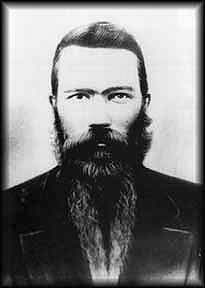
Portrait thought to be of Henry Berry Lowry. Via the State Archives of North Carolina
Henry Berry Lowry, a Lumbee Native American, was the head of the mostly Native outlaw group known as the Lowry Gang. In addition to typical outlaw activities, the Lowry Gang also helped other Native Americans avoid Confederate work conscription and fought alongside Union soldiers who had escaped Confederate prison camps. While Lowry did often resort to murder to settle personal feuds, he was also considered a sort of Robeson “Robin Hood.” When they committed robberies, they would often share the spoils with the community and would return items such as horses as soon as they were no longer needed. They were known to be “respectful” robbers and would let you off the hook if you could show you didn’t have much.
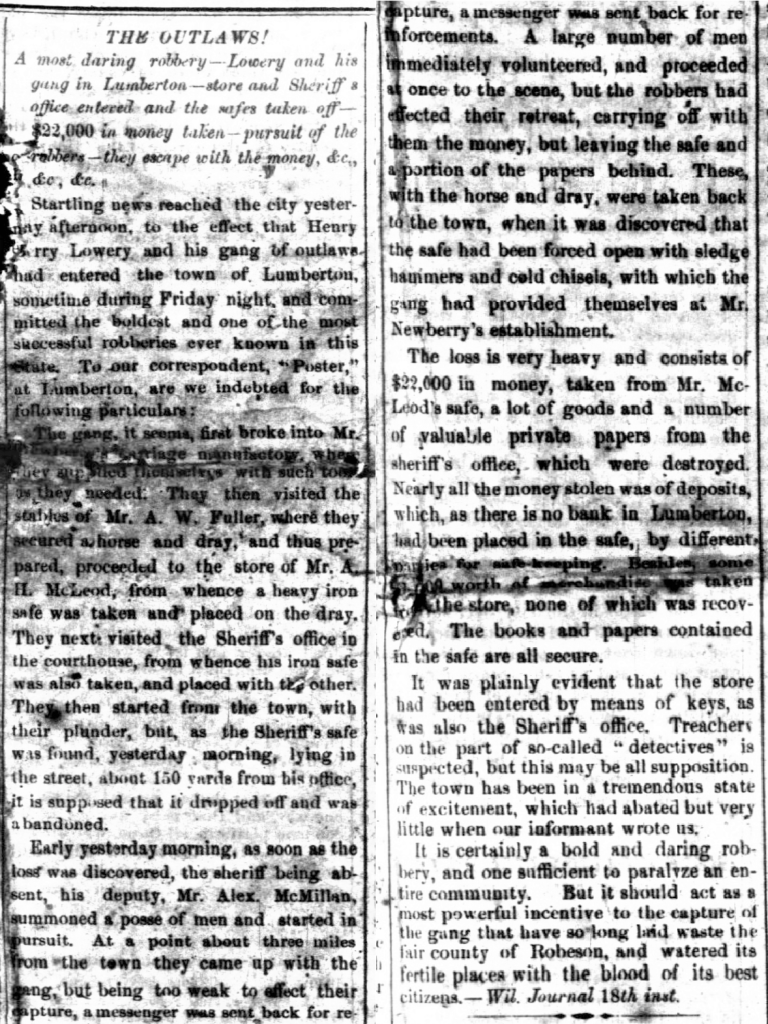
The Weekly Sentinel, February 28, 1872
In 1869, governor William Holden put a $12,000 bounty on Lowry’s head, which resulted in bloody conflict over the next few years. After successfully evading capture, Lowry planned his final heist in February of 1872. The gang stole a safe from a local carriage manufacturer and were bold enough to take another from the sheriff’s office, walking away with $22,000 (about $520,000 today) and then he disappeared. The bounty was never collected and he was never heard from again. Some locals claim they saw him at a friend’s funeral years later, but we will likely never know what happened to Henry Berry Lowry.
Over the next year, we’ll be adding millions of newspaper images to DigitalNC. These images were originally digitized a number of years ago in a partnership with Newspapers.com. That project focused on scanning microfilmed papers published before 1923 held by the North Carolina Collection in Wilson Special Collections Library. While you can currently search all of those pre-1923 issues on Newspapers.com, over the next year we will also make them available in our newspaper database as well. This will allow you to search that content alongside the 2 million pages already on our site – all completely open access and free to use.
This week’s additions include:
Asheboro
Charleston
Charlotte
Culler
Elizabeth City
Goldsboro
Greensboro
Halifax
Hertford
North Wilkesboro
Oxford
Plymouth
Raleigh
Red Springs
Reidsville
Rockingham
Rutherfordton
Salisbury
Sanford
Shelby
Tarboro
Taylorsville
Wadesboro
Warrenton
Washington
Winston-Salem
If you want to see all of the newspapers we have available on DigitalNC, you can find them here. Thanks to UNC-Chapel Hill Libraries for permission to and support for adding all of this content as well as the content to come. We also thank the North Caroliniana Society for providing funding to support staff working on this project.

This week we have another 34 titles up on DigitalNC! In this batch we have an article from the Durham Tobacco Plant describing the construction of a new factory being built by W. Duke, Sons & Co., which contained a machine that would revolutionize their tobacco business: The Bonsack machine.

Durham Tobacco Plant, July 16, 1884
In 1881, Virginia native James Bonsack created the first industrial cigarette rolling machine, a task that was done meticulously by hand up until this point. Bonsack partnered with W. Duke, Sons & Co. in 1884 and supplied them with one of his machines that could roll 250,000 cigarettes in a single day, the equivalent of 48 employees. While this acquisition would make the Dukes the leading cigarette producer in the country, the automation of the process forced many skilled rollers out of work.
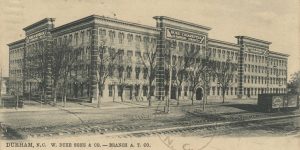
W. Duke, Sons & Co. 1884 factory. Image via opendurham.org
Over the next year, we’ll be adding millions of newspaper images to DigitalNC. These images were originally digitized a number of years ago in a partnership with Newspapers.com. That project focused on scanning microfilmed papers published before 1923 held by the North Carolina Collection in Wilson Special Collections Library. While you can currently search all of those pre-1923 issues on Newspapers.com, over the next year we will also make them available in our newspaper database as well. This will allow you to search that content alongside the 2 million pages already on our site – all completely open access and free to use.
This week’s additions include:
- The North Carolinian (Elizabeth City, N.C.) – 1869-1903
- The Yadkin Valley News (Mt. Airy, N.C.) – 1880-1895
- The Index (Wilkesboro, N.C.) – 1880-1881
- The News Reporter (Whiteville, N.C.) – 1912-1924
- The Montgomery Vidette (Troy, N.C.) – 1886-1891
- The Southern Vidette (Norwood, N.C.) – 1891-1892
- Carter’s Weekly (North Wilkesboro, N.C.) – 1920-1922
- The Alexander County Journal (Taylorsville, N.C.) – 1887-1888
- Washington Progress (Washington, N.C.) – 1892-1913
- The Chronicle (Wilkesboro, N.C.) – 1890-1911
- The Wilson Mirror (Wilson, N.C.) – 1887-1894
- Windsor Public Ledger (Windsor, N.C.) – 1887-1889
- Windsor Ledger (Windsor, N.C.) – 1889-1915
- The Daily Southerner (Tarboro, N.C.) – 1889-1922
- The Carolina Mountaineer and Waynesville Courier (Waynesville, N.C.) – 1917-1923
- Raleigh Christian Advocate (Raleigh, N.C.) – 1914
- The Elizabeth-City Star (Elizabeth City, N.C.) – 1822-1824
- The Elizabeth-City Star and North-Carolina Eastern Intelligencer (Elizabeth City, N.C.) – 1825-1833
- The North-Carolinian (Fayetteville, N.C.) – 1839-1864
- The Greensboro Patriot (Greensboro, N.C.) – 1888
- Durham Tobacco Plant (Durham, N.C.) – 1872-1885
- The Enquirer (Tarboro, N.C.) – 1871-1873
- The Times (Greensboro, N.C.) – 1856-1861
- Halifax Compiler (Halifax, N.C.) – 1818
- Halifax Minerva (Halifax, N.C.) – 1829-1830
- The Edenton Gazette, and North-Carolina Advertiser (Edenton, N.C.) – 1806-1809
- The Edenton Gazette (Edenton, N.C.) – 1809-1813
- The Edenton Gazette, and North-Carolina General Advertiser (Edenton, N.C.) – 1814-1822
- Edenton Gazette (Edenton, N.C.) – 1827-1831
- The N.C. Republican, and Civil Rights Advocate (Weldon, N.C.) – 1884
- The Weldon Patriot (Weldon, N.C.) – 1852-1859
- Railroad Ticket (Weldon, N.C.) – 1881
- The Semi-Weekly State (Weldon, N.C.) – 1867
- Webster’s Weekly (Reidsville, N.C.) – 1881-1916
If you want to see all of the newspapers we have available on DigitalNC, you can find them here. Thanks to UNC-Chapel Hill Libraries for permission to and support for adding all of this content as well as the content to come. We also thank the North Caroliniana Society for providing funding to support staff working on this project.
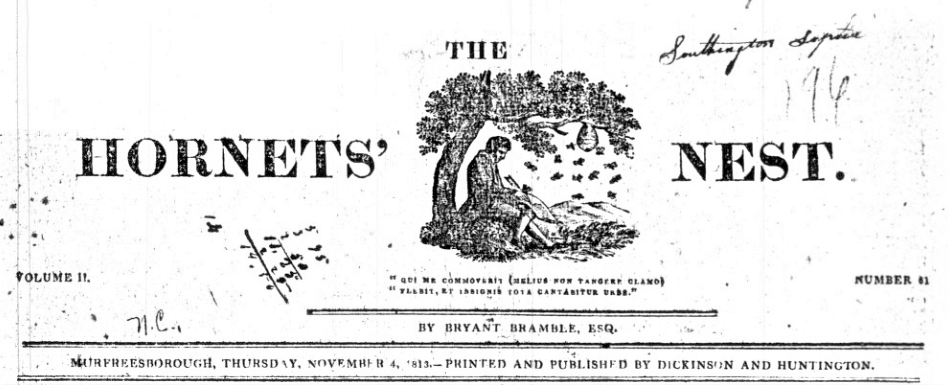
This week we have another 60 titles from all over the state up on DigitalNC, including a little piece of North Carolina railroad history!
On the second page of the January 15th, 1833 issue of the Fayetteville Observer, you’ll find a list of all the legislation enacted by the North Carolina General Assembly during the 1832-1833 session. One of these acts is the incorporation of the company that built North Carolina’s first functional railroad: The Experimental Rail Road Company of Raleigh.
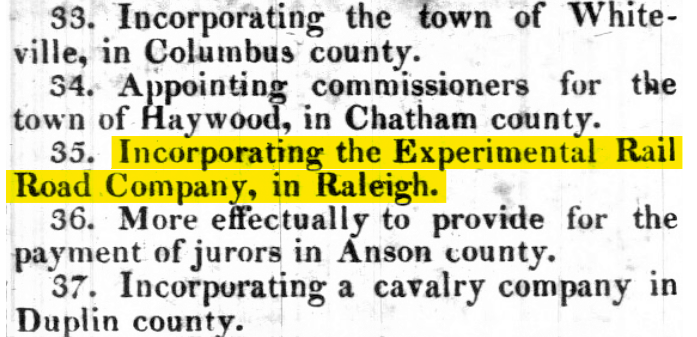
Fayetteville Observer, January 15, 1833
The one and one-quarter mile rail line extended from the Capitol Building, which had burned in 1831, to a quarry just east of Raleigh. When the horse-drawn rail carts weren’t transporting the stone used to rebuild the Capitol, people could ride the line in “pleasure cars” for a 25 cent fare. The line cost $2,700 to construct, which would be roughly $91,000 in 2022.
Over the next year, we’ll be adding millions of newspaper images to DigitalNC. These images were originally digitized a number of years ago in a partnership with Newspapers.com. That project focused on scanning microfilmed papers published before 1923 held by the North Carolina Collection in Wilson Special Collections Library. While you can currently search all of those pre-1923 issues on Newspapers.com, over the next year we will also make them available in our newspaper database as well. This will allow you to search that content alongside the 2 million pages already on our site – all completely open access and free to use.
This week’s additions include:
- The North Carolina Prohibitionist (Bush Hill, N.C.) – 1886-1888
- The Progress (Enfield, N.C.) – 1908-1922
- The North-Carolina Journal (Halifax, N.C.) – 1792-1810
- The News Reporter (Littleton, N.C.) – 1897-1923
- The Franklin Courier (Louisburg, N.C.) – 1872-1874
- The Madison Enterprise (Madison, N.C.) – 1873-1874
- The Monroe Journal (Monroe, N.C.) – 1923
- The Iredell Gazette (Mooresville, N.C.) – 1880
- The Morganton Herald (Morganton, N.C.) – 1891-1901
- Surry Visitor (Mount Airy, N.C.) – 1874-1876
- Cherokee Herald (Murphy, N.C.) – 1874-1876
- Person County Courier (Roxboro, N.C.) – 1890-1892
- North Carolina Argus (Wadesboro, N.C.) – 1848-1876
- Mecklenburg Times (Charlotte, N.C.) – 1889-1897
- The North Carolina Whig (Charlotte, N.C.) – 1863
- King’s Dollar Daily (Greenville, N.C.) – 1904
- King’s Weekly (Greenville, N.C.) – 1894-1909
- McDowell Democrat (Marion, N.C.) – 1905-1909
- Marion Progress (Marion, N.C.) – 1909-1922
- The Stanly Banner (Albemarle, N.C.) – 1876
- The Stanly Observer (Albemarle, N.C.) – 1884
- The Stanly News (Albemarle, N.C.) – 1892-1893
- The Caldwell Messenger (Lenoir, N.C.) – 1875-1876
- The Semi-Weekly News (Lenoir, N.C.) – 1900
- The Weekly News (Lenoir, N.C.) – 1900-1902
- The Magnolia Monitor (Magnolia, N.C.) – 1873-1876
- The Duplin Record (Magnolia, N.C.) – 1874-1875
- The Weekly Record (Magnolia, N.C.) – 1876-1877
- The Central (Lexington, N.C.) – 1876
- Lexington and Yadkin Flag (Lexington, N.C.) – 1855-1856
- The Lexington Herald (Lexington, N.C.) – 1915-1917
- The North State (Lexington, N.C.) – 1904-1908
- Murfreesboro Enquirer (Murfreesboro, N.C.) – 1876-1878
- The Albemarle Enquirer (Murfreesboro, N.C.) – 1878-1881
- The Hornets’ Nest (Murfreesboro, N.C.) – 1812-1813
- Carolina Chronicle (Murfreesboro, N.C.) – 1827
- Milton Intelligencer (Milton, N.C.) – 1819
- Milton Spectator (Milton, N.C.) – 1832-1839
- The Milton Chronicle (Milton, N.C.) – 1841-1888
- Milton Gazette & Roanoke Advertiser (Milton, N.C.) – 1824-1831
- The Milton Spectator (Milton, N.C.) – 1854
- The Lincoln Democrat (Lincolnton, N.C.) – 1895-1896
- The Lincoln Journal (Lincolnton, N.C.) – 1898-1901
- The Lincoln Courier (Lincolnton, N.C.) – 1891
- Lincoln Transcript (Lincolnton, N.C.) – 1836
- The Western Whig Banner (Lincolnton, N.C.) – 1840
- Lincoln Progress (Lincolnton, N.C.) – 1873-1882
- Economist (Elizabeth City, N.C.) – 1903
- The Weekly Economist (Elizabeth City, N.C.) – 1903-1905
- Daily Economist (Elizabeth City, N.C.) – 1905-1907
- North Carolina Advocate (Elizabeth City, N.C.) – 1833
- The Intelligencer, and Nag’s Head Advocate (Elizabeth City, N.C.) – 1840-1841
- The Elizabeth-City Gazette, and Public Advertiser (Elizabeth City, N.C.) – 1808
- Fayetteville Observer (Fayetteville, N.C.) – 1833
- The Public Spirit (Fayetteville, N.C.) – 1876
- The News (Fayetteville, N.C.) – 1865
- The Fayetteville Daily News (Fayetteville, N.C.) – 1865
- The Weekly Courier (Fayetteville, N.C.) – 1860
- Fayetteville Examiner (Fayetteville, N.C.) – 1880-1883
- Daily Telegraph (Fayetteville, N.C.) – 1865
If you want to see all of the newspapers we have available on DigitalNC, you can find them here. Thanks to UNC-Chapel Hill Libraries for permission to and support for adding all of this content as well as the content to come. We also thank the North Caroliniana Society for providing funding to support staff working on this project.


![Header for The Roanoke News. It reads: The Roanoke News. Established in 1866--Serving Halifax and North [H]ampton counties.](https://www.digitalnc.org/wp-content/uploads/2022/02/download.png)
